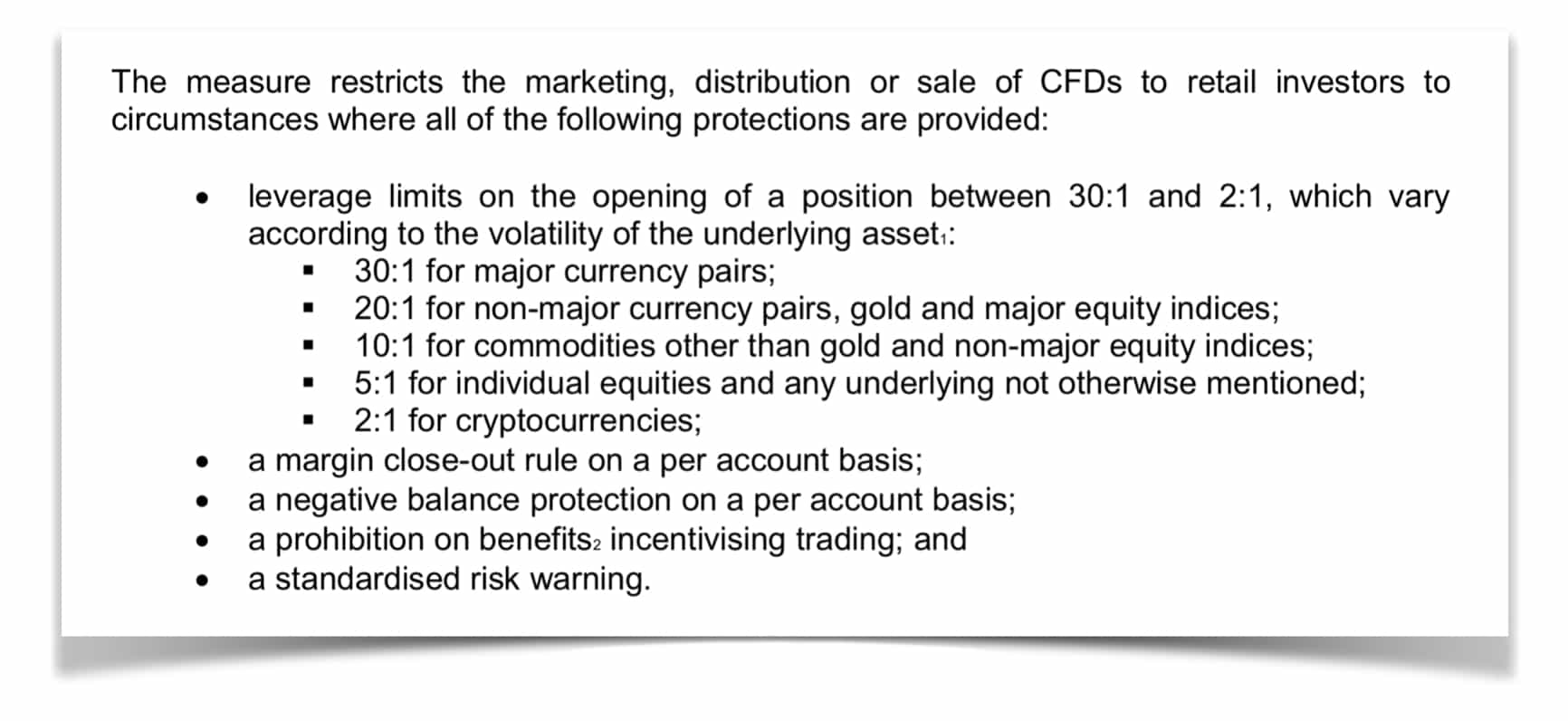The ESMA has just enforced a lot of new major regulations affecting all sorts of traders (1. August 2018). If you are a trader living in the EU, you may have to change your trading from now on. Many people despise these new changes and regulations because they feel like their trading will be very restricted. In this article, I will explain what exactly these new ESMA regulations are and how they will affect you and your trading.
Furthermore, I will tell you why things aren’t as bad as they seem and how to avoid these changes.
What is ESMA and What is their Goal:

First off, it is very important to understand what ESMA is and what they are trying to do. ESMA is the European Securities and Markets Authority.
Their goal is to protect investors and stabilize the European financial system. So these new ESMA regulations have been made to protect (retail) investors. ESMA does not believe that most retail investors are able to manage their risk and understand the complexity of ‘investment’ products like binary options and CFDs.
This is understandable because research from the NCA (National Competent Authorities) has shown that between 74% and 89% of CFD traders inside the EU lose money. Furthermore, their analysis shows that average losses vary from about $1800-$33’500. As you can see, the statistics don’t look too good.
So in other words, the goal of these ESMA change is to improve these statistics.
The Changes
Now let us get into the actual changes that ESMA is enforcing.
Binary Options
 This means that it isn’t allowed for a person or a firm (e.g. bank or broker) in the EU to offer binary options or to provide marketing material on binary options.
This means that it isn’t allowed for a person or a firm (e.g. bank or broker) in the EU to offer binary options or to provide marketing material on binary options.
In other words, the days of binary options (inside the EU) are over! You can’t trade binary options anymore.
Why are Binary Options getting Banned:
To understand this, I want you to look at two quotes from ESMA:

Let’s break this quote down. The first part of this quote says that binary options have an expected negative return. In my opinion, this is best understood with a simplified example game:
A coin has about a 50% probability of landing on heads and a 50% probability of landing on tails. If you would bet on one side, you would have a 50% probability of winning. A game with an expected negative return would work like this:
 You bet $1 on either heads or tails. If you are right, you receive $0.5 in profit (so $0.5 and your initial $1 stake). However, if you lose, you lose your entire $1 stake.
You bet $1 on either heads or tails. If you are right, you receive $0.5 in profit (so $0.5 and your initial $1 stake). However, if you lose, you lose your entire $1 stake.
On 100 rounds of this game, the expected outcome would be about 50 wins and 50 losses (because there is a 50% probability of winning). But as your gain always is less than your loss, you will lose money in the long run. So even if you would be lucky and win 60 times out of 100, you would still be at an overall loss because you lost $1 forty times and only won half a Dollar sixty times. That is an overall loss of $10.
I hope you can see how this game is unfair and has an expected negative return for you.
This is the exact way binary options work. The payout ratio of binary options is always less than the money put up to buy a binary option. So you will always lose more than you can win. Therefore, you will have to have an extraordinary good win rate just to break even.
Predicting very short-term price movements with a very high win rate is close to impossible even with some fancy indicators.
I want to give an example of how binary options work:
A common payout ratio of binary options is 70%. This means, if you pick the right direction, you will receive 70% of your initial ‘investment’ in profit. A payout ratio of 70% would mean that you would have to have a win rate of almost 60% just to break even.
I hope you can see how the odds are stacked against you when trading binary options.
Now let us move on to the second part of the quote: ‘embedded conflict of interest between providers and their clients’
Binary options are Over-The-Counter (OTC) derivative meaning that your broker is your counterparty. If your broker takes the opposite side of your trade, there exists an inherent conflict of interest! In other words, your broker wants you to lose so that he wins…
The second quote that I want you to look at is the following one:

The first part of this quote is referring to the above-described attribute of binary options. With an expected negative payout ratio and a conflict of interest, binary options aren’t anything else than a game in a casino. For instance, roulette or any other gambling game for that matter has an expected negative return. Furthermore, every casino wants its clients to lose so that they make money (conflict of interest).

The second part of the quote is basically saying that binary options have no purpose than to make binary option brokers rich. You can’t use binary options to hedge or to perform other similar functions like you could with other derivatives (e.g. futures, forwards, options…).
Furthermore, binary option brokers have been using some very shady promotional tactics. For instance, they have created huge amounts of fake accounts to spread lies about how lucrative binary options are. In addition to that, binary options have been heavily promoted through well-paying affiliate programs.
Hopefully, my breakdown of these two quotes and more sheds some light on why binary options are getting banned.
CFDs
Now let us move on to CFDs. Before I get into the changes made to CFDs, I just want to explain what exactly CFDs even are.
CFD stands for Contract for Difference and a CFD is an OTC derivative that you trade with your broker. As CFDs are OTC products, they can be customized with different leverage ratios, fees and more. CFDs can be traded on almost any product. They are most commonly used in Forex, however, it isn’t abnormal to see CFDs on stocks, ETFs, cryptocurrencies and more as well.
The profit and loss of a CFD is based on the difference between the current underlying asset’s trading price and the underlying asset’s price when opening the CFD position.
Let me give you an example:
XYZ is currently trading at $100 and you decide to buy one CFD on XYZ. After you open the trade, XYZ rallies $10 to $110. This would mean that you have a $10 profit on your CFD position since this is the difference between the current and initial underlying asset’s trading price.
If XYZ would have fallen $10 instead, you would have had a $10 loss on your CFD position.
Depending on the leverage ratio, these gains and losses can be magnified. Some brokers charge fees for certain actions such as holding CFDs overnight.
Hopefully, you now fully understand how CFDs work. Next up, I will explain the changes made to CFDs.
Different than binary options, CFDs have not been banned. Instead, CFD trading has been restricted to a certain extent.
Here is ESMA’s statement on the restrictions of CFDs:

Once again, I will break down and walk you through each of these changes, one at a time.
Let us start with the leverage limits.
Trading with leverage means trading on margin which means that you are borrowing money from your broker to increase your buying power. The amount that you can borrow depends on the broker. Some only offer leverage ratios of 2:1 (which means that every Dollar that you put up controls $2) and others offer(ed) leverage ratios of up to 500:1 (which means that every Dollar that you put up controls $500).
 ESMA wants to limit the amount of leverage available to retail investors. The leverage limit that they are enforcing varies from asset class to asset class. The most amount of leverage (30:1) is allowed on the, in their eyes, least volatile asset class (major currency pairs). The least amount of leverage (2:1) is allowed on the, in their eyes, most volatile asset class (cryptocurrencies). Thereby, they limit the risk that retail traders can maximally take.
ESMA wants to limit the amount of leverage available to retail investors. The leverage limit that they are enforcing varies from asset class to asset class. The most amount of leverage (30:1) is allowed on the, in their eyes, least volatile asset class (major currency pairs). The least amount of leverage (2:1) is allowed on the, in their eyes, most volatile asset class (cryptocurrencies). Thereby, they limit the risk that retail traders can maximally take.
This is probably the biggest change of them all. Instead of having access to 500:1 leverage, you will now only be able to trade with maximally 30:1 or even less leverage. You can see how much leverage is available for each asset class on the following image:

What does this mean you may ask yourself. When trading on leverage/with borrowed money, you will always have to put up a certain amount of money to trade. This capital acts as collateral and it is referred to as margin. The next restriction is a margin close-out rule on a per account basis.
This new margin close-out rule standardizes when your broker has to close your CFD positions. The required margin to open a (CFD) position is called the initial margin. If your total account margin falls below 50% of the initial margin requirement, your broker must close one or multiple of your CFD positions.
So if a CFD position goes too far against you and your account margin falls too much, your CFD position(s) may be closed for you by your broker.
This change goes hand in hand with the next one: a negative balance protection on a per account basis.
Before this change was enforced, retail CFD traders could lose more than they had in their brokerage account. If someone trades with high leverage and sudden unwanted market moves occur, he/she could have ended up with owing money to his/her broker.
This negative balance protection tries to fight this. With this rule, you can’t lose more money than deposited to your broker account. So you can’t be in debt to your broker due to losses in CFDs.
This is also the reason why brokers have to close your CFD position(s) if your margin falls to low. Otherwise, you could end up with owing money to your broker.
With the margin close-out rule and leverage limits, it is much less likely that your account balance could drop below zero. However, in certain flash crashes or other sudden big moves, your positions might still lose more than your total account capital. But due to this negative balance protection rule, the risk lies with your broker. In other words, it won’t be your problem anymore. If your CFD positions lose much more than you have in your account, your broker can’t charge you any additional money.
The next change is a prohibition on benefits incentivizing trading.
This basically means that brokers aren’t allowed to motivate retail traders to trade CFDs (or larger volumes of CFDs) by offering special benefits such as lower fees, volume-based discounts or other benefits.
Benefits that don’t incentivize retail traders to trade CFDs (or larger volumes of CFDs) are still allowed.
Last but not least, the marketing, distribution, and sale of CFDs may not occur inside the EU without a standardized risk warning such as the following one:
‘CFDs are complex instruments and come with a high risk of losing money rapidly due to leverage. Between 74-89 % of retail investor accounts lose money when trading CFDs. You should consider whether you understand how CFDs work and whether you can afford to take the high risk of losing your money.’
Summed up, CFDs may only be marketed, distributed and sold inside the EU if all of the just-described criteria is met.
Why are CFDs Restricted?
Different than binary options, CFDs aren’t totally illegitimate investment products. Nevertheless, they have some sketchy attributes and that is also the reason why they are being restricted.
Here are two sketchy features of CFDs that are partial causes of these regulations:
- Conflict of Interest: Just like binary options, CFDs also are Over-The-Counter (OTC) products which means that the broker will take the other side of your trade. Once again, this comes with a conflict of interest. The broker rather wants his position to work out than yours.
- High Leverage: The greater the leverage, the greater the risks. Leverage can magnify your losses just as much as it can magnify your gains. Sadly, most (newer) traders only focus on the increased potential profits rather than on the increase in risk. 500:1 leverage ratios that weren’t prohibited before could increase your losses by a 500-fold. Just think about that for a second! Every 1 point move against you would be multiplied by 500 per contract. High leverage has led to some disasters in the past, so it is only natural to see some regulations. Furthermore, ask yourself the question why a broker would allow you to trade with 500-times your money. Would you ever borrow anyone 500-times his money to trade highly risky assets?
My Take on the New ESMA Regulations
Many people are outraged about these controversial changes. They think their trading career just got eliminated through these regulations.
But let me tell you the truth…
- Binary options aren’t legitimate investment products and no one would ever make consistent money with them apart from the binary options broker!
- If you aren’t profitable without leverage, you most definitely won’t be with leverage! Trading with leverage ratios of 500:1 is borderline suicidal!
I know this isn’t the most popular of opinions. However, it is true. Most retail traders don’t actually know what they are doing. Therefore, these people are very easy victims of greedy brokers. Many people fall for the shady promotional tactics of brokers and end up losing their money due to this.
Generally speaking, trading profitably isn’t easy. But if you give yourself an additional huge statistical disadvantage, it is practically impossible to trade profitably.
I can’t be happier about the fact that binary options are finally getting banned. I have been criticizing binary options for all of the above reasons since I started TradeOptionsWithMe. So it is great to see them getting banned.
I don’t have anything against the leverage limits either. Like I stated above, I find it insane that any retail trader trades with leverage ratios of 500:1. You really don’t need that kind of leverage. Using such high leverage will just lead to you losing all your money.
Always remember, the reason why such high leverage ever was created is so that retail clients lose their money 500-times faster than usually. These leverage ratios are the method of how brokers can raid you of your money as fast and easy as possible.
Furthermore, negative balance protection is a great thing. This new regulation can truly protect you against disasters.
Note that these regulations only apply to retail traders and not to professional traders. Why?
Because:
- Professional traders know what they are doing
- Professional traders never would trade binary options
- Professional traders know how to manage risk
In other words, professional traders wouldn’t trade these insane products.
How to Avoid the New ESMA Regulations:
Like I said, I like these changes and think that they are a great step in the correct direction. They help to fight the exploitation of unknowing retail traders.
Always remember why these regulations were enforced in the first place: to protect you!
Nonetheless, there still are and will be people that despise these changes. Just like people hate on the PDT Rule, people will and are hating on these new ESMA regulations.
Luckily for them, there are methods to avoid these changes.
Before I present these methods, I just want to make it clear that I don’t necessarily recommend avoiding these regulations partly due to the reasons stated above.
Basically, there are two different ways to avoid these changes:
- Becoming a professional trader
Remember, these changes only apply to retail traders. So if you aren’t a retail trader, they won’t apply to you. Therefore, the first way to avoid these changes is to become a professional trader. This is easier said than done.
To change your status from retail to professional trader, you will have to meet at least two of the following three criteria:
- You have to have placed at least ten significant sized trades each quarter for the past four quarters.
- You need to have at least 500 000 Euro (about $577 000) in liquid equity.
- You need to be intimately familiar with CFD trading and have worked in the financial sector for at least 12 months.
As you can see, there are some serious requirements to become a professional trader. In my opinion, it is not worth it to become a professional trader just to avoid these regulations.
- Changing broker
The second way to avoid these changes is to change broker. By changing to a broker that isn’t stationed inside of the EU, you will be able to avoid these regulations.
However, I can’t recommend changing to an offshore broker. Most offshore brokers don’t have very trustworthy regulations and investor protections. This means, for instance, if the broker goes under, you won’t receive any of your money. This is a risk that I wouldn’t be willing to take. Generally, brokers based and regulated in countries like the Cayman Islands, Cyprus, Bahamas etc. usually aren’t very reliable.
Apparently, one of the only places to find reliable, trustworthy brokers that allow you to avoid these regulations is Australia.
I don’t recommend changing broker to avoid these regulations. But if you decide to do so anyway, make sure to do enough research so that your money is safe!
Note that by avoiding these regulations, you will also avoid things like negative balance protection which limits your risk as a trader/investor.
Conclusion
Now you should know what exactly the new ESMA regulations are and how they will affect you and your trading. In my opinion, it is good to see these regulations. But many people feel different about this.
There are some ways to avoid these regulations, but in my opinion, none of them are truly worth it.
I think everyone should accept these new regulations and should be happy about the fact that something is being done to protect against shady broker tactics. However, I am sure that these brokers will come up with new sketchy products and tactics to that aren’t banned or restricted yet.
Once again, I personally don’t think that you should trade with too high leverage anyway. Furthermore, no one but the binary option brokers should be sad over the fact that binary options are getting banned. I can’t say this often enough: binary options aren’t legitimate investment products!
What do you think about these changes? Do you have a similar view or are you outraged? Let me know in the comment section below!
If you have any questions, I would be happy to answer them in the comment section under this article.
To learn more about these regulations and further updates, make sure to visit ESMA’s website.


Perfect article, well presented. Didnt know about these new regulations. F*** binary options! Regulations of binary options was needed. Thank you O.
Thanks for the feedback. I totally agree. It is awesome to see binary options getting banned.
What a great read! What great content!
Love to read guys like you who really have that market pulse! It’s great to have a reference to go to about regulations.
Thanks again for the great read! I’ll be sure to keep an eye out going forward!
Onward and upward! Good trading!
Thanks a lot for the comment. Good trading to you as well!
I currently trade, well invest over a month period, in American tech stocks. I wouldn’t really call myself a trader because I tend to hold until the stocks hit the green…but I do appreciate that these regulations NEEDED to come into play at some point.
At the end of the day – people lose money when they treat the financial or stock markets like a fruit machine.
I’m also pleased to hear about the news surrounding binay options.
Would you call yourself a day trader or more of an investor (longer term) like myself?
Thanks for the comment Chris.
Actually, I would neither call myself a day trader nor investor. I would refer to myself as an active trader. I am not an investor because I don’t invest in stocks or anything else. I usually don’t hold trades for much longer than a month. But I wouldn’t necessarily call myself a day trader either as I don’t only day trade. I usually hold my options trades for multiple weeks.